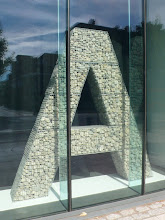Gallery 1 houses 'Take Care of Yourself' (2007) a project inspired by the receipt of an email from her then lover terminating the relationship. Calle has sent the email to 107 other women of a variety of ages and professions—from schoolgirls to mothers, from actresses to psychologists, from rifle shooters to accountants, and so on. The responses cover the gallery wall and are in the form of a photograph of each woman reading the missive alongside their response.

Each response is produced in a very visual, and often typographic way, for example, the rifle shooter has shot through the three instances of the word love and the email is displayed with a small white light sitting behind each of the holes; the children's story writer has interpreted the email in the form of a fable and it has been set as a children's book, complete with appropriate sized text and drop caps at the beginning of each paragraph; and the accountant produced a balance sheet of the relationship. Each of these responses is relevant to the position or role of the participant and to their interpretation of the text. This for me was an incredibly obvious demonstration of the reality of Barthes' notion of the 'death of the author' and the 'birth of the reader'. The words only became truly active through the reading of the text, and they acted in 107 different ways as each person brought their own set of experiences—personal, professional and cultural—to bear on the text. For example, the linguist highlighted the fact that the email began 'sophie', not 'dear sophie' or 'hello sophie', just 'sophie'. This, from a British perspective, was interpreted as a curt, somewhat sharp, opening gambit—one which the linguist wasn't sure would be read the same way in its original language. If anyone is reading this who has also read my recent post on the PhD design list that included comments about tone of voice, it was probably this tactic of starting emails 'Alison...' that I was referring to—it definitely makes me sit up straight and adopt a defensive position. But that is an aside... There is much more to say about this work I am sure, but go and see it for yourself.
A couple of other projects that really caught my eye dealt with absence and presence in terms of place and memory. Projects in Berlin and the Bronx inspired by residents' responses to place—in Berlin to symbols of East Germany that had been removed but that were still present in the minds of the community.

In the Bronx sites of personal meaning that people chose to take Calle to are documented with the execution of image and text done in what might be considered as a traditional field note diary form—images of the people at their place of choice alongside notes of their reasons for taking Calle there, their memories and notes of the exchange between the artist and participant itself.

This style is repeated in The Gotham Handbook (1998), another fantastic idea, that I don't have time to talk about here. But I wonder whether the move away from this traditional form of representation to a more expressive use of text was triggered by a realisation of the potential of text in the work or a simply a desire to escape the repetitive nature of the visual 'capturing' of the projects. I am not familiar enough with Calle's work to know her position on whether the work in the gallery is the 'art' or whether the engagement with people and place is the real art. It brings to mind the contrast with the work of Richard Long—another in the queue of blog posts awaiting to be made—who seems to have a very clear 'formula' for his use of text and image in the communicating of his walks. A bit more reading is in order to find this out...
I think one of the things that also caught my eye, and it perhaps links to this idea of Long's 'formula', was how strict Calle was about setting her guidelines and how short, in terms of time, some of the experiences were. For example in the Gotham City Handbook, often her observation of the phone box would last only 1 hour, during which a huge amount of things happened. I guess when one is dealing with the minutiae of the everyday even five minutes can provide meaningful encounters.
Lastly, in response to my own thinking about my practice submission, it was interesting to see how a range of projects came together under one roof, and functioned both as separate entities, but also contributed to the whole. There are definitely obvious central themes that are being explored, even though they are some differences in methodology and execution. This is something that I need to think about right now, and perhaps I could nail my themes as the 4 Ps: Place, page, process and pause.


No comments:
Post a Comment